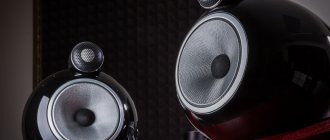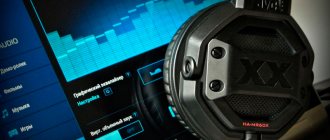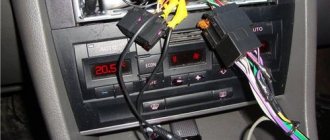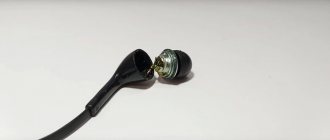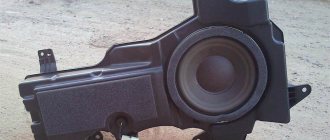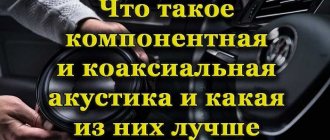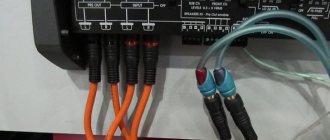Each musical instrument sounds in its own frequency range. Information about the sound boundaries of an instrument helps the sound engineer: mixing music is much easier when you know in what range a particular instrument sounds.
In order not to guess and not to search for the desired range, in 2012 the magazine “Sound On Sound” prepared a special table of frequencies of popular musical instruments. Since this cheat sheet was created for people who speak English, the editors of SAMESOUND.RU translated and adapted the table for Russian musicians.
Automatic filter
Low frequencies have more energy than high frequencies. When it comes to compression, the activation of the compressor is caused by some kind of audio signal, but the compressor does not care about its frequency component. It turns out that the entire spectrum of frequencies in the signal drives the compressor, but sometimes this leads to problems: after compression, it seems that there is too much low end in the mix or signal. Since we are talking about bass, the bottom may stick out too much forward.
To overcome this, you can cheat: make sure that the low frequencies do not drive the compressor, but still pass through it. To do this, the compressor will need a sidechain send with a BP filter or a sidechain with a certain frequency range. The iZotope Neutron 2 compressor module has a Detection Filter feature that can help us.
In the image above the compressor is running in standard single band mode. However, there is an HP filter nearby, set to 400 Hz. Due to its participation in the Detection Circuit, the filter cuts off low frequencies from the signal entering the sidechain, but not from the entire audio chain.
A little theory
Sound is the propagation of mechanical vibrations in a gaseous or liquid medium. Like any wave, sound has parameters such as amplitude (characterizes volume) and frequency (characterizes tonality).
The average person's ear is capable of detecting sound with frequencies ranging from 16-20 Hz to 15-20 kHz. In turn, this range has three “steps”:
- 20-150 Hz – low frequencies.
- 150-7000 Hz – mid frequencies.
- 7-20 kHz – high frequencies.
The higher the vibration frequency, the higher the pitch of the sound. For example, a bumblebee, which flaps its wings slowly, hums, and a mosquito, the frequency of whose wings flapping is significantly higher, squeaks vilely, hiding in the darkness.
Sound below the audibility range is called infrasound, from 20 kHz ultrasound. The human ear does not perceive them, but such sounds with a large amplitude can have an effect on the body.
This range is fully perceived by a person with perfect pitch. In conditions of constant background noise, the ability to perceive the entire spectrum of frequencies deteriorates over time.
In addition, with age, almost every person is susceptible to senile hearing loss, when high-frequency sound is not perceived.
Biologically, it is determined that women perceive high frequencies better, and also better distinguish intonations and tones, which is influenced by the need to care for offspring.
For the same reason, most of the fair sex are difficult to deceive - they are able to detect any falsehood in the voice. It is also worth noting that in women, hearing begins to deteriorate by the age of 40, while in men this process starts at 30.
In relation to speakers, the sounds of human speech and music are primarily of interest. There are significantly fewer aesthetes who listen to the sounds of wildlife on the computer compared to film buffs and music lovers.
Sidechain activation with a barrel
In most music, the kick and bass are played simultaneously, especially on the downbeat. When they sound together, two instruments appear in the mix, occupying the low-frequency range, while the bass also has great sustain. To avoid collisions and struggle for range, you need to make sure that the kick gives attack and the bass sustains.
This division of responsibilities is possible if you set the compressor so that it quickly weakens the bass when the kick drum appears. It sounds a little complicated, but the technique is very simple. This can be done in any compressor with sidechain support (Waves, standard DAW plugins), but we will look at an example based on Neutron 2.
Place Neutron on the bass track and activate its compressor. Use a sidechain connected to an external signal source (Ext Full) - this way you will send a signal from another track to the compressor, bypassing any filtering.
The main input of the plugin is Bus 3, which receives the kick drum signal. Thanks to routing, the compressor will weaken the bass with each kick hit, and we will get the desired result: attack from the kick, sustain from the bass. It’s difficult to name specific compressor settings here - everything is individual and depends on how much you want to highlight the bass.
We recommend useful links on the topic:
• Frequency ranges
- a large number of different frequency lists
• Frequency table
- a unique interactive database collected by observers
What are radio waves
Radio waves are electromagnetic waves that travel through space at the speed of light (300,000 km/sec). By the way, light also belongs to electromagnetic waves, which determines their very similar properties (reflection, refraction, attenuation, etc.). Radio waves carry energy emitted by an electromagnetic oscillator through space. And they are born when the electric field changes, for example, when an alternating electric current passes through a conductor or when sparks jump through space, i.e. a series of rapidly successive current pulses. Electromagnetic radiation is characterized by frequency, wavelength and power of transferred energy. The frequency of electromagnetic waves shows how many times per second the direction of the electric current changes in the emitter and, therefore, how many times per second the magnitude of the electric and magnetic fields changes at each point in space. Frequency is measured in hertz (Hz), a unit named after the great German scientist Heinrich Rudolf Hertz. 1 Hz is one vibration per second, 1 megahertz (MHz) is a million vibrations per second. Knowing that the speed of electromagnetic waves is equal to the speed of light, we can determine the distance between points in space where the electric (or magnetic) field is in the same phase. This distance is called the wavelength. The wavelength (in meters) is calculated using the formula: or approximately where ¦ is the frequency of electromagnetic radiation in MHz.
The formula shows that, for example, a frequency of 1 MHz corresponds to a wavelength of approx. 300 m. As the frequency increases, the wavelength decreases, with a decrease - guess for yourself. In the future, we will make sure that knowledge of the wavelength is very important when choosing an antenna for a radio system, since the length of the antenna directly depends on it. Electromagnetic waves travel freely through air or outer space (vacuum). But if a metal wire, antenna or any other conducting body meets on the path of the wave, then they give up their energy to it, thereby causing an alternating electric current in this conductor. But not all the wave energy is absorbed by the conductor; part of it is reflected from the surface. By the way, this is the basis for the use of electromagnetic waves in radar. Another useful property of electromagnetic waves (as well as any other waves) is their ability to bend around bodies in their path. But this is only possible when the dimensions of the body are smaller than the wavelength or comparable to it. For example, in order to detect an aircraft, the length of the locator radio wave must be less than its geometric dimensions (less than 10 m). If the body is longer than the wavelength, it can reflect it. But it may not reflect it - remember the American Stealth stealth aircraft. The energy carried by electromagnetic waves depends on the power of the generator (emitter) and the distance to it. Scientifically, it sounds like this: the energy flow per unit area is directly proportional to the radiation power and inversely proportional to the square of the distance to the emitter. This means that the communication range depends on the power of the transmitter, but to a much greater extent on the distance to it. For example, the energy flow of electromagnetic radiation from the Sun onto the Earth's surface reaches 1 kilowatt per square meter, and the energy flow of a medium-wave broadcast radio station is only thousandths and even millionths of a watt per square meter.
Spectrum Allocation
Radio waves (radio frequencies) used in radio engineering occupy the region, or more scientifically, spectrum from 10,000 m (30 kHz) to 0.1 mm (3,000 GHz). This is only part of the vast spectrum of electromagnetic waves. Radio waves (in decreasing length) are followed by thermal or infrared rays. After them comes a narrow section of visible light waves, then a spectrum of ultraviolet, x-rays and gamma rays - all these are electromagnetic vibrations of the same nature, differing only in wavelength and, therefore, frequency. Although the entire spectrum is divided into regions, the boundaries between them are tentatively outlined. The regions follow one another continuously, transition into one another, and in some cases overlap. By international agreements, the entire spectrum of radio waves used in radio communications is divided into ranges:
| Wave band name | Wavelength | ||
| 3–30 kHz | Very Low Frequencies (VLF) | Myriameter | 100–10 km |
| 30–300 kHz | Low frequencies (LF) | Kilometer | 10–1 km |
| 300–3000 kHz | Mid frequencies (MF) | Hectometric | 1–0.1 km |
| 3–30 MHz | High frequencies (HF) | Decameter | 100–10 m |
| 30–300 MHz | Very high frequencies (VHF) | Meter | 10–1 m |
| 300–3000 MHz | Ultra high frequencies (UHF) | decimeter | 1–0.1 m |
| 3–30 GHz | Ultrahigh frequencies (microwave) | Centimeter | 10–1 cm |
| 30–300 GHz | Extremely high frequencies (EHF) | Millimeter | 10–1 mm |
| 300–3000 GHz | Hyper high frequencies (HHF) | decimmillimeter | 1–0.1 mm |
But these ranges are very extensive and, in turn, are divided into sections that include the so-called broadcasting and television ranges, ranges for land and aviation, space and sea communications, for data transmission and medicine, for radar and radio navigation, etc. Each radio service is allocated its own section of the spectrum or fixed frequencies.
An example of spectrum allocation between different services [1]. This breakdown is quite confusing, so many services use their own "internal" terminology. Typically, when designating ranges allocated for land mobile communications, the following names are used:
| Term | Frequency range | Explanations |
| Shortwave (HF) | 2–30 MHz | Due to its propagation characteristics, it is mainly used for long-distance communications. |
| "CB" | 25.6–30.1 MHz | Civil band in which private individuals can use communications. In different countries, from 40 to 80 fixed frequencies (channels) are allocated in this area. |
| "Low Band" | 33–50 MHz | Range of mobile landline communications. It is not clear why, but in the Russian language there was no term defining this range. |
| VHF | 136–174 MHz | The most common range of mobile landline communications. |
| DCV | 400–512 MHz | Range of mobile landline communications. Sometimes this section is not allocated as a separate range, but they say VHF, meaning the frequency band from 136 to 512 MHz. |
| "800 MHz" | 806–825 and 851–870 MHz | Traditional "American" range; widely used by mobile communications in the United States. It has not gained much popularity among us. |
The official names of frequency ranges should not be confused with the names of sections allocated for various services. It is worth noting that the world's major manufacturers of equipment for mobile land communications produce models designed to operate within these particular areas. In the future, we will talk about the properties of radio waves in relation to their use in land mobile radio communications.
How do radio waves travel?
Radio waves are emitted through an antenna into space and propagate as electromagnetic field energy. And although the nature of radio waves is the same, their ability to propagate strongly depends on the wavelength. The earth is a conductor of electricity for radio waves (albeit not a very good one). Passing over the surface of the earth, radio waves gradually weaken. This is due to the fact that electromagnetic waves excite electric currents in the surface of the earth, which consumes part of the energy. Those. energy is absorbed by the earth, and the more, the shorter the wavelength (higher the frequency). In addition, the wave energy weakens also because the radiation propagates in all directions of space and, therefore, the further the receiver is from the transmitter, the less energy falls per unit area and the less it gets into the antenna. Transmissions from long-wave broadcast stations can be received at distances of up to several thousand kilometers, and the signal level decreases smoothly, without jumps. Medium wave stations can be heard within a range of thousands of kilometers. As for short waves, their energy decreases sharply with distance from the transmitter. This explains the fact that at the dawn of the development of radio, waves from 1 to 30 km were mainly used for communication. Waves shorter than 100 meters were generally considered unsuitable for long-distance communications. However, further studies of short and ultrashort waves showed that they quickly attenuate when they travel near the Earth's surface. When the radiation is directed upward, short waves return back. Back in 1902, the English mathematician Oliver Heaviside and the American electrical engineer Arthur Edwin Kennelly almost simultaneously predicted that there is an ionized layer of air above the Earth - a natural mirror that reflects electromagnetic waves. This layer was called the ionosphere. The Earth's ionosphere should have made it possible to increase the range of propagation of radio waves to distances exceeding line of sight. This assumption was experimentally proven in 1923. Radio frequency pulses were transmitted vertically upward and the returning signals were received. Measuring the time between sending and receiving pulses made it possible to determine the height and number of reflection layers.
Propagation of long and short waves [2].
After being reflected from the ionosphere, short waves return to the Earth, leaving hundreds of kilometers of “dead zone” underneath. Having traveled to the ionosphere and back, the wave does not “calm down”, but is reflected from the surface of the Earth and again rushes to the ionosphere, where it is again reflected, etc. Thus, being reflected many times, a radio wave can circle the globe several times. It has been established that the reflection height depends primarily on the wavelength. The shorter the wave, the higher the height at which it is reflected and, therefore, the larger the “dead zone”. This dependence is true only for the short-wave part of the spectrum (up to approximately 25–30 MHz). For shorter wavelengths the ionosphere is transparent. The waves penetrate through it and go into outer space. The figure shows that reflection depends not only on frequency, but also on the time of day. This is due to the fact that the ionosphere is ionized by solar radiation and gradually loses its reflectivity with the onset of darkness. The degree of ionization also depends on solar activity, which varies throughout the year and from year to year on a seven-year cycle.
Reflective layers of the ionosphere and the propagation of short waves depending on frequency and time of day [1].
Propagation of short and ultrashort waves [2].
VHF radio waves have properties more similar to light rays. They are practically not reflected from the ionosphere, bend around the earth's surface very slightly and spread within the line of sight. Therefore, the range of ultrashort waves is short. But this has a definite advantage for radio communications. Since waves in the VHF range propagate within line of sight, radio stations can be located at a distance of 150–200 km from each other without mutual influence. This allows neighboring stations to reuse the same frequency. The properties of radio waves in the DCV and 800 MHz ranges are even closer to light rays and therefore have another interesting and important property. Let's remember how a flashlight works. Light from a light bulb located at the reflector's focal point is collected into a narrow beam of rays that can be sent in any direction. Much the same can be done with high-frequency radio waves. They can be collected by antenna mirrors and sent out in narrow beams. It is impossible to build such an antenna for low-frequency waves, since its dimensions would be too large (the diameter of the mirror must be much larger than the wavelength). The possibility of directed radiation of waves makes it possible to increase the efficiency of the communication system. This is due to the fact that a narrow beam provides less energy dissipation in side directions, which allows the use of less powerful transmitters to achieve a given communication range. Directional radiation creates less interference with other communication systems that are not in the beam range. Radio wave reception can also take advantage of directional radiation. For example, many are familiar with parabolic satellite antennas, which focus the radiation of the satellite transmitter to the point where the receiving sensor is installed. The use of directional receiving antennas in radio astronomy has made it possible to make many fundamental scientific discoveries. The ability to focus high-frequency radio waves has ensured their widespread use in radar, radio relay communications, satellite broadcasting, wireless data transmission, etc.
Parabolic directional antennas [1].
It should be noted that as the wavelength decreases, their attenuation and absorption in the atmosphere increases. In particular, the propagation of waves shorter than 1 cm begins to be affected by such phenomena as fog, rain, clouds, which can become a serious interference that greatly limits the communication range. We have learned that radio waves have different propagation properties, and each part of this range is used where its advantages can best be exploited.
Illustrations: Britannica online, Britannica.com Inc., https://www.britannica.com/
Dichenko A.A., Uzbekistan; https://www.viol.uz
Adding Power to Your Sound with the Transient Editor
Due to poor quality of the instrument, incorrect settings or playing habits, the bass may lack sustain. There is no way to fix problems with the sustain equalizer: equalization will change the timbre and character of the bass, affect the overall sound of the mix, but will not solve the problem.
This is where a transient shaper comes in handy as it can change the attack and sustain. In the image above, the transient editor is running in multi-band mode: the first band is activated, the second is not, the third is activated but in bypass mode. Band 1 is tuned to frequencies below 500 Hz - everything below this mark is boosted by 4 dB with the Sustain slider. Thanks to this, only the sustain in the lower range is processed, all other frequencies remain untouched.
Brief table of audio frequencies from iZotope
iZotope also created its own audio frequency table, but made it much more compact. In contrast to the extensive work of Sound On Sound, iZotope specialists provided data in their own table only for the most popular musical instruments: male and female voices, drum kits and guitars.
iZotope decided not to overload musicians with information, dividing the instruments into three groups: vocals, percussion and fretted instruments (the most necessary according to the authors). Despite the less information content, we also translated the table.
In the archive below you will find the table in PDF format. The document is easy to read and fits onto A4 sheet without any problems. The only negative that we found in the original document is the absence of margins for bleeds and other useful typographic information. In any case, even without this data, the table does not lose its usefulness for musicians.
frequency-chart-izotope-rus.zip – Downloaded 1 time – 1 MB
If you have downloaded the tables, we will be happy to thank you in the form of reposting this post to your social networks or subscribing to our Telegram channel @samesound. Good luck with your creativity!
Sound frequency table. Version history
1.0.19 (18.02.2018)
Errors corrected and text edits made.
1.0.18 (12.01.2018)
First version of the table.
Original tables: SOUNDONSOUND, iZotope
Gives a vintage film effect for styling in the mix
Bassists and sound engineers love the sound of bass recorded on analog tape. Due to careful compression and overtones, the bass sound fits perfectly into the mix. If you consider yourself a connoisseur of vintage sound and dream of a characteristic analog-film sound, you don’t have to buy a cassette deck - just use the Exciter module in iZotope Neutron 2.
To make film emulation more realistic, work in single-strip mode. After activating the plugin, add an exciter module to the interface, set the XY controller to Tape mode, and adjust the sound with the Drive slider. When clearly noticeable overloads and distortions appear in the signal, move the slider back a little.
Summary
- The electromagnetic spectrum refers to the range of EMR frequencies present in the universe. This spectrum is divided and subdivided into different frequency ranges.
- The main section related to radio frequency communication is called the radio frequency spectrum, and the radio frequency spectrum is divided into 8 bands.
- Mutual interference between separate radio systems can be avoided by using different carrier frequencies.
- Bandwidth and propagation requirements influence the choice of carrier frequency, and the carrier frequency in turn influences the performance of a particular system.
- The highest frequency range in the radio frequency spectrum represents the transition from signals that behave more like radio waves to signals that behave more like optical waves.
Original article:
- The Many Frequencies of RF Communication
Taming random, particularly low sounds
As with an electric guitar, some bass sounds can jump out of the mix and sound lower than other notes. There are many reasons for this: features of the bass player’s technique, the instrument itself, the amplifier and other equipment used during recording. This behavior of the bass can be corrected by selective equalization.
Activate the first processing band in the equalizer and switch it to Dynamic Mode. Make a cut around 80 Hz - in our example, a huge amount of extra signal appears in this place. Following this, add a static HP filter at 23 Hz - this will minimize the rumbling sub-bass frequencies throughout the instrument.
From EMR to light
The above satellite frequencies primarily remain in the microwave/SHF section of the radio spectrum. The EHF/EHF band serves as a transition between radio waves and optical waves; Microwave signals are more seriously blocked by gases and moisture in the atmosphere, and this reminds us of optical radiation and its inability to penetrate opaque objects. Signals with frequencies above the EHF band are classified as infrared radiation rather than radio waves:
Optical frequency bands
Removing turbidity
In arrangements with bass and kick drum playing at the same time, it is quite difficult to make these instruments work together. One of them will definitely get lost against the background of his friend, which is why the dense and strong bottom of the mix will be destroyed. This can be corrected using the “Carving Space” compensation technique.
The essence of the method is simple: the amplification of the frequencies of one instrument must be compensated by the attenuation of the same frequencies of another instrument. For example, you increased the frequency of 95 Hz in the bass, which means that the same frequency needs to be mirrored attenuated in the kick drum. This approach minimizes frequency collisions between these instruments - the kick drum and bass will not compete for the same frequency ranges.
You can do this mirror processing using any equalizers installed in your system. If you use the Neutron 2 equalizer, then life becomes even easier: the equalizer provides inverse frequency processing - the plug-in will automatically boost or attenuate frequencies on the adjacent track.
In the image above, the kick drum is selected as the masking source (Neutron is running on the kick drum track). The Inverse Link button is active - the plugin will automatically attenuate or enhance bass frequencies when processing a kick.
Frequencies: why and how
Before discussing the different categories of frequencies, let's look at two main issues. Why do we use so many different frequencies? And how does a developer determine which frequency is appropriate for a particular application?
Interference
Two or more transmitters operating on the same frequency cause interference, that is, they make it difficult for the receiving device to separate the relevant RF signal from the irrelevant RF signals. This problem largely disappears when using different frequencies. EMR at one frequency does not “damage” EMR at another frequency, and irrelevant signals are easily ignored through filtering.
Adequate frequency separation allows you to ignore the interfering signal
Of course, interference does not disappear just because the two signals are separated by a few hertz: greater frequency separation results in less mutual interference. However, using different frequencies for different types of radio communications is surprisingly effective: every day, around the world, numerous wireless systems operate simultaneously without significant loss of functionality.
Frequency selection
EMR characteristics vary depending on frequency. For example, waves at extremely low frequencies can penetrate water effectively and therefore can be useful when you need to communicate with a submarine. As another example, some frequencies allow a radio signal to travel very long distances because these frequencies experience atmospheric refraction. The fact is that the main objectives of a particular radio frequency system greatly influence the process of selecting the operating frequency range.
Ionospheric refraction (refraction) provides communication over long distances
The previous paragraph mentioned examples in which frequency affects propagation characteristics. However, bandwidth (in analogue systems) or data rate (in digital systems) is often more important.
If you want to wirelessly transmit an audio signal with frequency components up to 10 kHz, you cannot use a transmission frequency (i.e. carrier) of 5 kHz. Frequency corresponds to the speed at which a signal transmits information, so you cannot "stuff" 10 kHz of audio information into a 5 kHz carrier. In addition, practical considerations require that the carrier frequency be significantly higher than the information (i.e., low frequency) frequency. Thus, systems with wider bandwidths and higher data rates must occupy higher frequency regions of the electromagnetic spectrum.
Fast parallel processing
Parallel compression and parallel saturation are popular techniques for processing and enhancing bass guitar. Using these techniques in a DAW will require multiple buses and sends, and proper signal routing. When working with Neutron 2, processing becomes simpler: each plug-in module is equipped with a Master Mix knob for independent and parallel processing of up to 6 effects without any additional settings.
The image shows that each module has its own vertical slider (note the area highlighted in red). By the way, the screenshot demonstrates a mixture of aggressive compression and active saturation, whose ratio is adjusted by the same Mix slider.
Where to buy an audio power amplifier
You can buy an audio power amplifier at an affordable price on the website of our partners Unitsolutions. Below we have compiled a list of the most current solutions in different price categories.
BKR BR-GD350
Our selection opens with an inexpensive class D amplifier, the BKR BR-GD350 with a power of 500 W. The device uses a switching power supply and focuses on operational reliability: the package includes Teflon wire that is resistant to overheating, and the cooling system allows the device to operate over a wide temperature range.
CROWN XLS 1002
A two-channel Class D power amplifier, CROWN XLS 1002 has built-in surge protection, is equipped with a digital processor with DSP and allows you to adjust the input sensitivity for each channel. Output power - 1100 W.
APART CONCEPT1
APart CONCEPT1 is a two-channel 100-watt power amplifier. The device is capable of operating in mono mode with two zones at once and volume control for each of them. Controlled via RS232 bus or using a remote control (not included in delivery).
RCF AM 2320
RCF AM 2320 is a single-channel amplifier with a power of 320 W. Designed for integration into various public address systems or for broadcasting. There are 4 microphone and 2 AUX inputs.

